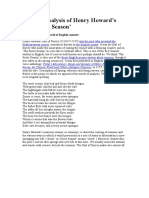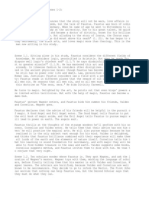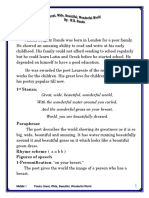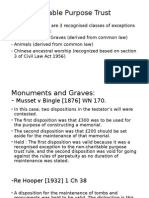I Wander Lonely
I Wander Lonely
Uploaded by
soskahobbaCopyright:
Available Formats
I Wander Lonely
I Wander Lonely
Uploaded by
soskahobbaOriginal Title
Copyright
Available Formats
Share this document
Did you find this document useful?
Is this content inappropriate?
Copyright:
Available Formats
I Wander Lonely
I Wander Lonely
Uploaded by
soskahobbaCopyright:
Available Formats
The poet;
William Wordsworth is a great romantic poet. He was brought up in the
arms of the nature and wrote about those wonderful places when he grew up. He
was crowned as a poet laureate, the greatest honuor England gives to the poets.
1st stanza
I wandered lonely as a cloud
That floats on high o'er vales and hills.
When all at once I saw a crowed,
A host, of golden daffodils;
Beside the lake beneath the trees,
Fluttering and dancing in the breeze.
Paraphrase
The poet says while he was walking alone without any aim, like a cloud
Which flies high over valley and hills, he suddenly saw a large number of the
daffodils. They were beside the lake and under the trees. They were moving and
dancing in the gentle air.
Rhyme scheme; ( a b a b c c )
Figures of speech
1- simile ; " as a cloud "
The poet likens himself to a cloud.
2- Personification; " fluttering and dancing "
The poet gives the daffodils the image of people who move and dance.
Devices
Contrast ; ( lonely x crowd ) ( o'er x under ) ( vales x hills )
Alliteration ; ( high - hills ) ( beside - beneath ) to give music to
appeal our sense of hearing.
Middle 1 Poetry I wandered lonely as a cloud K.M. Shehata 01116555956 1
2nd stanza
Continuous as the stars that shines
And twinkle in the Milky Way,
They stretched in never- ending line
Along the margin of a bay:
Ten thousand saw I at a glance,
Tossing their heads in sprightly dance.
Paraphrase
The poet goes on in describing the daffodils as they were shining continuously
like stars in the universe. They were lying in a very long line which you cannot see its end a
long the edge of the gulf of the lake. He could see about ten thousand in one look. They were
raising up their heads in a beautiful dance.
Figures of speech
1- Simile : " as the stars "
The poet likens the daffodils to stars.
2- Personification: " Tossing their heads in a sprightly dance"
The poet gives the daffodils the image of people who raise up their Heads and dance.
3 rd
stanza
The waves beside them danced; but they
Outdid the sparkling waves in glee :
A poet could not but be gay,
In such a jocund company :
I gazed and gazed but little thought
What wealth the show to me had brought:
Paraphrase
The poet saw the waves in the lake beside the daffodils dancing but the
daffodils were dancing more beautifully. The poet could not do anything except
feeling happy on seeing such a happy group. He looked very closely at this scene
which brought him great happiness.
Figures of speech
1- Personification ; " The waves beside them danced "
The poet gives the waves the image of people who can dance.
Devices
Middle 1 Poetry I wandered lonely as a cloud K.M. Shehata 01116555956 2
1- Alliteration ( what - wealth ) to give music to appeal our sense of hearing.
4th stanza
For oft, when on my couch I lie
In vacant or in pensive mood,
They flash upon that inward eye
Which is the bliss of solitude;
And then my heart with pleasures fills,
And dances with the daffodils.
Paraphrase
The poet often lies on his sofa while he is busy or free minded, the daffodils
appear in his mind and they become happiness in his loneliness. His heart becomes
full of happiness and dances with the daffodils.
Figures of speech
1- Personification " And dances with the daffodils "
The poet gives his heart the image of a person who can dance.
Devices
1- Contrast (vacant x pensive )
2- Alliteration (dances – daffodils) to give music.
Commentary
As a romantic poet William Wordsworth shows his great love to the nature.
He describes it perfectly well. He shows his happiness when he sees the happy
nature. The poet uses simple but beautiful language with many figures of speech like;
simile and personification. The poet shows his great skill and rich vocabulary in
using many words to express happiness in the 3rd stanza (glee – gay – jocund –
wealth). The poet uses devices, contrast and alliteration, well. The rhyme scheme is
simple and regular.
Questions & answers
1- What is meant by “poet laureate “?
It is a title England gives to its great poets. It is the highest honour the poet can
have. In the Arab world Ahmed Shawki is the poet laureate of the Arabic poetry.
2- What is the Romanticism?
It is a new method in the world of art and literature. It appeared in the
eighteenth and the nineteenth centuries. It depends on the love of nature, feeling
lonely, showing personal experience and clear ideas.
3- How is William Wordsworth's poem a good example for the romanticism?
" I wandered lonely as a cloud " is a good example of romantic poetry as it is
for the love of the nature, the poet describes a personal experience, the poet was
alone and the lines are beautiful and clear.
Middle 1 Poetry I wandered lonely as a cloud K.M. Shehata 01116555956 3
4- What is the main theme of the poem?
Man feels happy when he sees the happy nature.
5- What is the main comparison of the poem?
The poet compares between the daffodils and the waves in the lake. They both
danced beautifully but the daffodils were better.
Middle 1 Poetry I wandered lonely as a cloud K.M. Shehata 01116555956 4
You might also like
- PROGRAMSDocument56 pagesPROGRAMSMatrix Destiny82% (11)
- Sonnet 116Document19 pagesSonnet 116Zesa S. BulabosNo ratings yet
- The Lady of ShalottDocument5 pagesThe Lady of ShalottAjla KaralicNo ratings yet
- Poetry Introduction & DayDocument16 pagesPoetry Introduction & Daysoskahobba75% (4)
- Case : The "OfDocument7 pagesCase : The "OfdaugschoNo ratings yet
- Daffodils: William WordsworthDocument3 pagesDaffodils: William WordsworthThe SiblingsNo ratings yet
- Wandered Lonely As A Cloud Is A Poem Known For Its Exceptional Simplicity, Yet ReDocument11 pagesWandered Lonely As A Cloud Is A Poem Known For Its Exceptional Simplicity, Yet ReAnushkaNo ratings yet
- Wordsworth Resolution and IndependenceDocument3 pagesWordsworth Resolution and IndependenceCASEYKNo ratings yet
- The Wild Swans at Coole by William Butler YeatsDocument4 pagesThe Wild Swans at Coole by William Butler Yeatssandip pandeyNo ratings yet
- A Short Analysis of Henry Howard's The Soote Season'Document2 pagesA Short Analysis of Henry Howard's The Soote Season'Ali MohamedNo ratings yet
- Stop All The Clocks Analysis - W.H. AudenDocument1 pageStop All The Clocks Analysis - W.H. Audenmoogs97No ratings yet
- Ophelia HandoutDocument4 pagesOphelia HandoutLeilyn Mae AbellarNo ratings yet
- Lucy GrayDocument2 pagesLucy GrayHarshit PaulNo ratings yet
- Lines Written in Early SpringDocument6 pagesLines Written in Early SpringMrinmoy Baruah100% (1)
- Hopkins - The WindhoverDocument3 pagesHopkins - The WindhoverCarmen VoicuNo ratings yet
- Critical Anlysis, Themes and SummaryDocument7 pagesCritical Anlysis, Themes and SummaryKashif MehmoodNo ratings yet
- The Wild Swans at CooleDocument2 pagesThe Wild Swans at CooleyoloNo ratings yet
- Ode To A SkylarkDocument10 pagesOde To A SkylarkSoma BiswasNo ratings yet
- Solitary ReaperDocument2 pagesSolitary ReaperKirstenalex100% (2)
- William WordsworthDocument19 pagesWilliam WordsworthAlina MonicaNo ratings yet
- 1 - Pope - An Essay On CriticismDocument2 pages1 - Pope - An Essay On CriticismSarha FiorenzaNo ratings yet
- The Tables TurnedDocument8 pagesThe Tables TurnedPetrisor Diana0% (1)
- To A Skylark - NotesDocument7 pagesTo A Skylark - Notesannmarytitus22No ratings yet
- Curse For A NationDocument18 pagesCurse For A NationsambidhasudhaNo ratings yet
- Dr. Faustus SummaryDocument8 pagesDr. Faustus SummaryMegha JainNo ratings yet
- Snowdrop - Ted HughesDocument2 pagesSnowdrop - Ted HughesKhushi ShahNo ratings yet
- The World Is Too Much With Us AnalysisDocument1 pageThe World Is Too Much With Us Analysisuberuber12No ratings yet
- Dramatic Monologue by MD Melon BeswasDocument2 pagesDramatic Monologue by MD Melon Beswasmd.melonNo ratings yet
- The Wild Swans at CooleDocument9 pagesThe Wild Swans at CooleSree Gopal Panjabi MahalNo ratings yet
- September 1913Document17 pagesSeptember 1913api-236470498100% (2)
- UlyssesDocument13 pagesUlyssesemilyjaneboyleNo ratings yet
- John Keats As Aan EscaptistDocument2 pagesJohn Keats As Aan Escaptistجاوید اقبال صدیقیNo ratings yet
- LULLABY AnalysisDocument3 pagesLULLABY AnalysisRegine RegayaNo ratings yet
- Meg 4Document13 pagesMeg 4arun1974No ratings yet
- Introduction:-: Amjad 1Document14 pagesIntroduction:-: Amjad 1Saleem RazaNo ratings yet
- The Study of Poetry by Matthew Arnold - Poetry FoundationDocument28 pagesThe Study of Poetry by Matthew Arnold - Poetry FoundationShenbhaga NeelaNo ratings yet
- Lucy GrayDocument4 pagesLucy GrayDash Hunter100% (4)
- The Lake Isle of Innisfree EssayDocument1 pageThe Lake Isle of Innisfree EssayyissifNo ratings yet
- Edmund Spenser (1552 - 1599) Like As A ShipDocument5 pagesEdmund Spenser (1552 - 1599) Like As A ShipHaneen Al Ibrahim100% (1)
- The Rime of The Ancient Mariner by Samuel Taylor Coleridge Was First Published in TheDocument9 pagesThe Rime of The Ancient Mariner by Samuel Taylor Coleridge Was First Published in TheAndreiStefanNo ratings yet
- Ode To The West WindDocument2 pagesOde To The West WindCaterina100% (1)
- Ode To The West WindDocument7 pagesOde To The West WindmnogalesNo ratings yet
- HopeDocument4 pagesHopeAsadRawootNo ratings yet
- DesignDocument20 pagesDesignprageethNo ratings yet
- The Wilde Swans at CooleDocument12 pagesThe Wilde Swans at CooleTiadivad100% (1)
- Coming - Philip Larkin: L.O. Understanding How Larkin Uses Language To Arouse Anticipation and Cheer in His AudienceDocument11 pagesComing - Philip Larkin: L.O. Understanding How Larkin Uses Language To Arouse Anticipation and Cheer in His AudienceArun MishraNo ratings yet
- ENG Honours PoetryDocument12 pagesENG Honours PoetryWungreiyon moinao100% (1)
- Bright StarDocument2 pagesBright StarDaraNo ratings yet
- We Are Seven William WordsworthDocument24 pagesWe Are Seven William WordsworthBianca Maria FurtosNo ratings yet
- The Wild Swans at Coole - NotesDocument3 pagesThe Wild Swans at Coole - NotesiffinichonchubhairNo ratings yet
- A Nice Cup of Tea EssayDocument2 pagesA Nice Cup of Tea EssayBrito RajNo ratings yet
- La Belle Dame Sans MerciDocument6 pagesLa Belle Dame Sans Merci123 AbcNo ratings yet
- Preferential Treatment of Nature in Romantic PoetryDocument4 pagesPreferential Treatment of Nature in Romantic PoetryIJAR JOURNALNo ratings yet
- Arundhati Roy.Document2 pagesArundhati Roy.Khawar ShahzadNo ratings yet
- I Taste A Liquor Never BrewedDocument2 pagesI Taste A Liquor Never BrewedNikolina PrskaloNo ratings yet
- The HippopotamusDocument5 pagesThe HippopotamusHari MohanNo ratings yet
- Three YearsDocument48 pagesThree Yearsiola90No ratings yet
- LUCYDocument3 pagesLUCYnanikloversNo ratings yet
- Ode To The West WindDocument1 pageOde To The West WindSudhakar Raj100% (1)
- What Literary Devices Are Used in - Death, Be Not Proud - by John DonneDocument2 pagesWhat Literary Devices Are Used in - Death, Be Not Proud - by John DonneJunaid KhanNo ratings yet
- Holy Willie's Prayer (Original) Holy Willie's Prayer (Translation)Document2 pagesHoly Willie's Prayer (Original) Holy Willie's Prayer (Translation)asdNo ratings yet
- I Wander LonelyDocument4 pagesI Wander LonelysoskahobbaNo ratings yet
- The PoetDocument4 pagesThe Poetsoskahobba0% (1)
- The Poet: William Wordsworth (1770 - 1850) : William Wordsworth Was Born in Cumberland, England, and AttendedDocument8 pagesThe Poet: William Wordsworth (1770 - 1850) : William Wordsworth Was Born in Cumberland, England, and Attendedsoskahobba100% (1)
- PeaceDocument4 pagesPeacesoskahobba75% (4)
- The Poet: William Wordsworth (1770 - 1850) : William Wordsworth Was Born in Cumberland, England, and AttendedDocument8 pagesThe Poet: William Wordsworth (1770 - 1850) : William Wordsworth Was Born in Cumberland, England, and Attendedsoskahobba100% (1)
- What Is The Difference Between The Ontological Trinity and The Economic TrinityDocument8 pagesWhat Is The Difference Between The Ontological Trinity and The Economic TrinityChris DupuisNo ratings yet
- Bài tập G11.1 - 19.08Document3 pagesBài tập G11.1 - 19.08Thanh Xuan Le HuynhNo ratings yet
- Central Bank of Kenya ActDocument35 pagesCentral Bank of Kenya ActDiana WangamatiNo ratings yet
- 31 28 Terminal Info For Unloading - Loading - StorageDocument7 pages31 28 Terminal Info For Unloading - Loading - Storageenciu georgeNo ratings yet
- Non-Charitable Purpose TrustDocument8 pagesNon-Charitable Purpose TrusttiqahNo ratings yet
- Full Course AISDocument121 pagesFull Course AISAHMED ABDALLAHNo ratings yet
- Electrocyclic Reactions (CHEM-311)Document16 pagesElectrocyclic Reactions (CHEM-311)Khadija MazharNo ratings yet
- Lessons From The PR Scandals of 2016Document6 pagesLessons From The PR Scandals of 2016Baliboola.N.ivanNo ratings yet
- Test (17-10-2023)Document7 pagesTest (17-10-2023)030437210048No ratings yet
- North Ocean Shipping Co - LTD CaseDocument18 pagesNorth Ocean Shipping Co - LTD CaseRobinSinglaNo ratings yet
- Code GereralDocument176 pagesCode GereralaldomanjakaNo ratings yet
- Local Media5499848111194883804Document4 pagesLocal Media5499848111194883804Erika MagdaraogNo ratings yet
- Active Directory BookDocument51 pagesActive Directory BookSaddam MullaNo ratings yet
- Unit Converter With The Most Common UnitsDocument14 pagesUnit Converter With The Most Common UnitsDan SabadusNo ratings yet
- 179 97 PBDocument11 pages179 97 PBmikeguitarc topexNo ratings yet
- Johnson BeverageDocument6 pagesJohnson BeverageShouib Mehreyar100% (1)
- f11 Pro Drone With Camera ManualDocument13 pagesf11 Pro Drone With Camera ManualMarco Antonio HerreraNo ratings yet
- Dating SystemsDocument16 pagesDating SystemsBaraCudaNo ratings yet
- Inventory Management - HeritageDocument6 pagesInventory Management - Heritagemohammed khayyumNo ratings yet
- Summative Test No. 1 (Fabm g11)Document3 pagesSummative Test No. 1 (Fabm g11)robelyn veranoNo ratings yet
- From Hunters and Gatherers To FarmersDocument40 pagesFrom Hunters and Gatherers To FarmersAdam100% (1)
- Windows 8Document13 pagesWindows 8sarwan111291No ratings yet
- DTP AtencioDocument24 pagesDTP AtencioDonavel Nodora JojuicoNo ratings yet
- Bates V Post Office: Louise Dar Witness StatementDocument31 pagesBates V Post Office: Louise Dar Witness StatementNick Wallis100% (1)
- Milton Friedman, "The Case For The Negative Income Tax: A View From The Right."Document17 pagesMilton Friedman, "The Case For The Negative Income Tax: A View From The Right."Jonathan HendersonNo ratings yet
- Trouble in Mind As Recorded by JRDocument2 pagesTrouble in Mind As Recorded by JRA21JokerNo ratings yet
- DISH Further Reply To SpaceX ESIM Use 6-13-22Document6 pagesDISH Further Reply To SpaceX ESIM Use 6-13-22michaelkan1No ratings yet
- AgreementDocument14 pagesAgreementMuhammad AnwarNo ratings yet






























































































